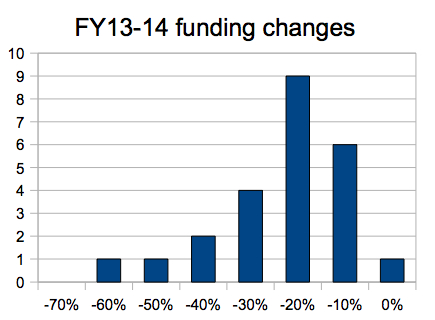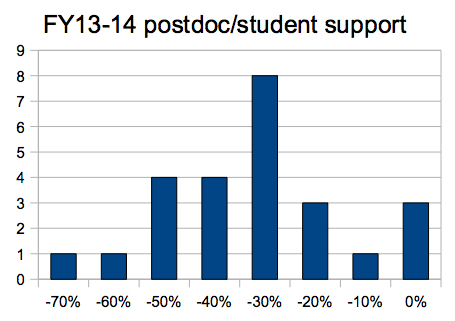One of the nice things that governments do is support basic scientific research — work that might help us better understand how the world works, but doesn’t have any direct technological or economic application. Particle physics and cosmology are great examples. In the U.S., much of the funding for these fields comes from the Office of High Energy Physics within the Office of Science at the Department of Energy (DOE).
Now that support is crumbling — drastically. In the last couple of years, the DOE has radically changed how it carries out reviews of different university theory groups, to decide how much grant support each will get. All for ostensibly good reasons — leveling the playing field and all that. But, without much fanfare, the actual result has been a significant drop in funding for almost every major theory group in the country.
Laurence Yaffe of the University of Washington, a respected particle and nuclear theorist, just released an analysis he informally carried out after serving a temporary assignment at the DOE. Here is his abstract (emphasis mine):
Impacts of Recent Comparative Review Cycles on DOE-funded High Energy Theory
L.G. Yaffe, University of Washington
February 19, 2014A summary is presented of data obtained from a grass-roots effort to understand the effects of the FY13 and FY14 comparative review cycles on the DOE-funded portion of the US high energy theory community and, in particular, on graduate students and postdoctoral researchers who are beginning their careers. For a sample comprised of nearly all of the larger groups undergoing comparative review, total funding declined by an average of 23%, with numerous major groups receiving reductions in the 30–55% range. Funding available for postdoc or graduate student support declined over 30%, with many reductions in the 40–65% range. The total number of postdoc positions in this large sample of theory groups is declining by over 40%. The impacts on young researchers raise grave concerns regarding continued U.S. leadership in high energy theory.
A 20% cut in funding in one year is kind of a big deal. A picture is worth a thousand words, so here are two of them; overall funding changes for all the different groups:
and changes specifically in support for graduate students and postdocs:
Obviously this is unsustainable, unless as a society we make the decision that particle physics just isn’t worth doing. But hopefully things can be rectified at least a bit, to restore some of that money. Everyone I know is bemoaning the cuts, complaining that they have been turning away prospective grad students and postdocs more than ever before. I’m not necessarily against decreasing the number of postdocs (as opposed to grad students); the pipeline has to narrow somewhere, and there’s a sensible argument to be made to do it at that point. But we should do it deliberately and after thinking and talking about it, not as the haphazard result of some new bureaucratic procedures. It would be a shame to destroy our future prospects in this centrally important area of science.


And yet a Blue Brain Project gets one billion Euro over 10 years no less. Public curiosity or need? There are brain disorders to fix, but there are many other disorders just as vital. It won’t create new energy. What is its value other than mere potential that we might discover something useful. It will be interesting, but not necessarily useful. I will leave you with the puzzle of science funding.
No one can help you until you decide to help yourself. The only way you are going to be able to help yourself is to stop being in denial of understanding ’empty’ space has mass and is what waves in a double slit experiment.
JoAnne: thanks for that insider info. Can I say though that infighting would be forgotten if the theory community had some exciting discoveries to re-ignite public and political enthusiasm. And there’s a whole cascade of them sitting around like windfall fruit. But within the standard model, not beyond it. For example see gamma-gamma pair production. A photon doesn’t actually morph into a positron and an electron. Pair production doesn’t occur because pair production occurs. It occurs because there’s a photon-photon interaction. When a photon interacts with itself just so, we call it an electron. Or a positron. Which is antimatter. And the proton is more like the positron than it’s like the electron. And so on.
Your posts are challenging and diverse John, which is good against the run of the mill, I would run with photons in theoretical physics – focus entirely upon them and their gravitational interactions as a start. Although I might not agree with your formalisms, everything hinges on photons. We explore properties of particles and antiparticles, but photons make them, break them, and recreate them. We have CMB dominating the universe because of their absolutely basic capacities for transmutations (or it would dominate if it hadn’t wound down).
I love particles as much as the next person, but photons are the “real deal” – gravitons and their interactions with photons by gravitation remain to be properly theorized (I would suggest not using a Higgs but using a graviton that both attracts and comprises the inertial mass attracting or being attracted as one equal intact field-particle). Indeed, despite the formalism for photons as momentum without rest mass, they can be likewise more properly formalized as field-particles (enabling their particle transmutations). It’s all about formalisms John, and basically rewriting them to get a better perspective on physics – but I concur with your focus on the photon in the above post.
I responded to JoAnne privately, but have been persuaded that clarifying a few things publicly is desirable. I agree with her that the level of support of science is an underlying issue. But a different and equally valid issue is the allocation of those resources which are available. My study examined some of the impacts of recent funding decisions, and tried to present the results as straightforwardly as possible. The data speak for themselves. JoAnne suggests that my data set is not representative — perhaps there is a significant number of groups who were not badly cut and who declined to share data. Of the larger (>= 4 faculty FTE) DOE supported theory groups who underwent review in FY13 or FY14, only four such groups were missing from my dataset. I do not think it credible to believe that outcomes for these four groups were so dramatically different as to significantly perturb the overall picture. It is true that my dataset is not representative of small (1 or 2 faculty) theory groups. As described, this was by design. These groups rarely host postdocs and tend to have few supported students. Such groups account for a minority of supported faculty. A huge shift in funding from large to small groups is a logical possibility — but it not something I believe is credible.
JoAnne mentions salary caps (whose imposition was described in my report). One can wonder if much of the cuts in overall funding shown were the result of the salary cap. The answer is no. As my footnote on salary caps indicated, the size of the impact of salary caps on the entire HEP program is not that big. Moreover, if salary caps were responsible for much of the total funding cuts, then there would have been no corresponding negative impact on funding for students and postdocs. (Or rather, if the salary cap caused funds to be redirected from summer salaries of senior faculty toward improved support for young researchers, as originally intended, then one would have seen positive changes in the distribution in changes in student and postdoc support.)
Regarding weakness in the FY13 postdoc hiring cycle, I simply do not understand what JoAnne is reading into what I wrote. My report said nothing about how the postdoc hiring cycle played out in 2013 (or 2014). It just reports what I learned from the groups who shared data: funding cuts are leading to the elimination of a large number of postdoc positions. Some of those eliminations have already taken place, some will not hit until next year. One may wonder whether this loss of postdoc positions resulting from FY13 and FY14 funding decisions differs, qualitatively, from impacts on postdocs which resulted from FY12 reviews. The answer is that there is a significant difference. FY12 funding decisions did result in the loss of some postdoc positions, but these losses were associated with faculty whose funding was not renewed. For groups whose faculty reviewed well, in FY12, there was no big hit on postdoc positions. In the FY13 and FY14 information I received, it appears that the majority of postdoc eliminations are not associated with faculty de-fundings.
My report presents data on the impact of recent funding decisions, in as straightforward a way as possible. I tried hard to put the data in context and present results in a manner which would not be misleading. The high energy theory community needs to understand and adapt to the changes which are underway. I believe it is correct to say that the impacts on young researchers raise serious concerns about continued U.S. leadership in high energy theory. Whether this matters is, of course, an issue on which opinions may differ. I stand by the concluding message of my report: everyone concerned with the future health of high energy theory in the U.S. should be encouraged to communicate to DOE’s Office of High Energy Physics their views on whether recent decisions affecting HEP theory represent a good allocation of available resources.
Pingback: Links 2/25/14 | Mike the Mad Biologist